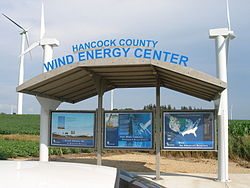Hancock County | |
|---|---|
 Visitor kiosk at the 148 wind turbine farm | |
 Location within the U.S. state of Iowa | |
 Iowa's location within the U.S. | |
| Coordinates: 43°05′00″N93°44′11″W / 43.083333333333°N 93.736388888889°W | |
| Country | |
| State | |
| Founded | 1851 |
| Named after | John Hancock |
| Seat | Garner |
| Largest city | Garner |
| Area | |
• Total | 573 sq mi (1,480 km2) |
| • Land | 571 sq mi (1,480 km2) |
| • Water | 2.0 sq mi (5.2 km2) 0.4% |
| Population (2020) | |
• Total | 10,795 |
• Estimate (2023) | 10,615 |
| • Density | 18.9/sq mi (7.30/km2) |
| Time zone | UTC−6 (Central) |
| • Summer (DST) | UTC−5 (CDT) |
| Congressional district | 4th |
| Website | hancockcountyia |
Hancock County is a county in the U.S. state of Iowa. As of the 2020 census, the population was 10,795. [1] The county seat is Garner. [2] The county was founded on January 15, 1851, and named in honor of John Hancock, a leader of the Continental Congress during the American Revolution. [3]



